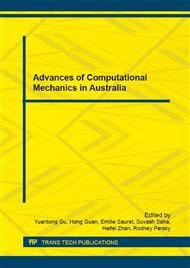[1]
J. Franklin, Suggested method for determining point load strength, in International Journal of Rock Mechanics and Mining Sciences & Geomechanics Abstracts, 1985, pp.51-60.
DOI: 10.1016/0148-9062(85)92327-7
Google Scholar
[2]
S. Galindo-Torres, D. Pedroso, D. Williams, and L. Li, Breaking processes in three-dimensional bonded granular materials with general shapes, Computer Physics Communications, vol. 183, pp.266-277, (2012).
DOI: 10.1016/j.cpc.2011.10.001
Google Scholar
[3]
S. G. T. Somayeh Behraftar, Alexander Scheuermann, David J. Williams, Eduardo Antonio G. Marques, Hossein JAnjani, A novel calibration methodology to obtain material parameters for the representation of fracture mechanics based on discrete element simulations, International Journal of Rock Mechanics and Mining Sciences 2015 (under revision).
DOI: 10.1016/j.compgeo.2016.08.029
Google Scholar
[4]
S. Galindo-Torres, F. Alonso-Marroquín, Y. Wang, D. Pedroso, and J. M. Castano, Molecular dynamics simulation of complex particles in three dimensions and the study of friction due to nonconvexity, Physical Review E, vol. 79, p.060301, (2009).
DOI: 10.1103/physreve.79.060301
Google Scholar
[5]
S. Galindo-Torres, A coupled Discrete Element Lattice Boltzmann Method for the simulation of fluid–solid interaction with particles of general shapes, Computer Methods in Applied Mechanics and Engineering, vol. 265, pp.107-119, (2013).
DOI: 10.1016/j.cma.2013.06.004
Google Scholar
[6]
J. B. M. Heslin, Site-Specific Correlation of the Point Load Index for the Hamersley Formation, Bachelor of Engineering Thesis, School of Civil Engineering, University of Queensland, October (2014).
Google Scholar
[7]
J. Rusnak and C. Mark, Using the point load test to determine the uniaxial compressive strength of coal measure rock, in Proceedings of the 19th International Conference on Ground Control in Mining. Morgantown, WV: West Virginia University, 2000, pp.362-371.
Google Scholar
[8]
ISRM, Suggested Method for Determing Point Load Strength, International Journal of Rock Mechanics: Blue Book, vol. 22, pp.51-60, (2007).
Google Scholar
[9]
E. Hoek, Rock mechanics laboratory testing in the context of a consulting engineering organization, in International Journal of Rock Mechanics and Mining Sciences & Geomechanics Abstracts, 1977, pp.93-101.
DOI: 10.1016/0148-9062(77)90201-7
Google Scholar
[10]
Z. Bieniawski, The point-load test in geotechnical practice, Engineering Geology, vol. 9, pp.1-11, (1975).
Google Scholar
[11]
E. Broch and J. Franklin, The point-load strength test, in International Journal of Rock Mechanics and Mining Sciences & Geomechanics Abstracts, 1972, pp.669-676.
DOI: 10.1016/0148-9062(72)90030-7
Google Scholar
[12]
C. O'Sullivan, Particulate discrete element modelling: Taylor & Francis, (2011).
Google Scholar


